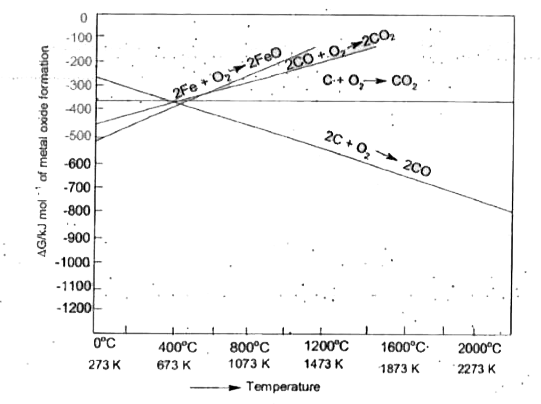Metals are extracted from their ores by a wide variety of techniques. The most common ores are oxides. Most metals are obtained by direct treatment of theirs ores with chemical agents, but the extraction of certain others require electrolysis. An example of the former type of process is the extraction of iron from its oxide, described by the following equation :
Fe2O3+3C→2Fe+3CO
The relative ease of extraction of a metal from its oxide can be estimated using the Ellingham diagram, as shown in the figure.
The diagram plots the free energies of formation of various oxides per mole of consumed oxygen as a function of absolute temperature.

Which of the following best explains why the free energy of formation of Fe2O3 becomes less negative as the temperature is increased.
A
The free energy of formation is independent of the absolute temperature.
B
Entropy drops as a result of the consumption of oxygen.
C
At low temperature, the free energy of formation becomes less dependent on the enthalpy of formation.
D
As entropy increases, the free energy of formation increases.
Text Solution
The correct Answer is:B
|
Topper's Solved these Questions
- ORES AND METALLURGYBook:FIITJEEChapter:ORES AND METALLURGYExercise:MATRIX-MATCH THE FOLLOWING QUESTIONS
Explore 3 Videos
- ORES AND METALLURGYBook:FIITJEEChapter:ORES AND METALLURGYExercise:MATCHING LIST TYPE QUESTIONS
Explore 3 Videos
- ORES AND METALLURGYBook:FIITJEEChapter:ORES AND METALLURGYExercise:COMPREHENSION - II
Explore 2 Videos
- NUCLEIC ACID AND VITAMIN Book:FIITJEEChapter:NUCLEIC ACID AND VITAMIN Exercise:ASSIGNMENT PROBLEMS (OBJECTIVE)
Explore 15 Videos
- PERIODIC PROTERTIES OF ELEMENTSBook:FIITJEEChapter:PERIODIC PROTERTIES OF ELEMENTSExercise:COMPREHENSION
Explore 13 Videos
Similar Questions
Knowledge Check
Metals are extracted from their ores by a wide variety of techniques. The most common ores are oxides. Most metals are obtained by direct treatment of theirs ores with chemical agents, but the extraction of certain others require electrolysis. An example of the former type of process is the extraction of iron from its oxide, described by the following equation :
Fe2O3+3C→2Fe+3CO
The relative ease of extraction of a metal from its oxide can be estimated using the Ellingham diagram, as shown in the figure.
The diagram plots the free energies of formation of various oxides per mole of consumed oxygen as a function of absolute temperature.

All of the following reagents could be used to extract lead from its oxide exceptAMolecular fluorineBMolecular boronCMolecular NitrogenDElemental carbonMetals are extracted from their ores by a wide variety of techniques. The most common ores are oxides. Most metals are obtained by direct treatment of theirs ores with chemical agents, but the extraction of certain others require electrolysis. An example of the former type of process is the extraction of iron from its oxide, described by the following equation :
Fe2O3+3C→2Fe+3CO
The relative ease of extraction of a metal from its oxide can be estimated using the Ellingham diagram, as shown in the figure.
The diagram plots the free energies of formation of various oxides per mole of consumed oxygen as a function of absolute temperature.
FIITJ∃CHEMB04_C02E07009_Q01.png width=80%><br>Whenferric⊗isreduced→obta∈ironmηl,CO_(2)orCOcanbe∏uced.The∏uctionofCO_(2)Ais directily proportional to the temperatureBis inversely proportional to the temperatureCis independent of the temperatureDrequires cooling of the COThe extraction of metal from the ore is
Aan oxidation processBa reduction processCa hydration processDa neutratlisaiton process
The extraction of metals from oxide ores involves
View SolutionThe extraction of metals from their ores by electrolysis is called :
View SolutionThe common method of extraction of metals from oxide ores is
View SolutionThe common method of extraction of metals from oxide ore involves
View SolutionThe most common method of extraction of metals from oxide ores involve
View Solution
